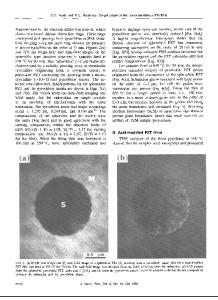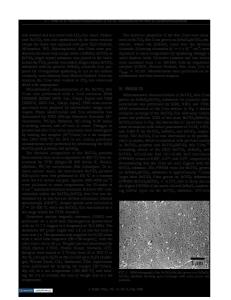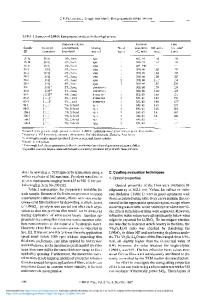Microstructural and Electrical Characterization of (Ba,Sr)TiO 3 Thin Films Prepared by a New Carboxylate Free Chemical S
- PDF / 597,210 Bytes
- 5 Pages / 595 x 842 pts (A4) Page_size
- 67 Downloads / 301 Views
C8.17.1
Microstructural and Electrical Characterization of (Ba,Sr)TiO3 Thin Films Prepared by a New Carboxylate Free Chemical Solution Deposition (CSD) route. Sandip Halder1, Theodor Schneller1 and Rainer Waser1,2 1 Institute Für Werkstoffe dr Elektrotechnik- II, RWTH Aachen, Germany 2 Institut fur Festkoerperforschung, Forchungzentrum Juelich, Juelich, Germany
ABSTRACT A new type of alkoxide precursor was developed to avoid the formation of the oxocarbonate phase as an intermediate phase during crystallization. The precursors were synthesized from Ba metal, Sr metal and aminoethanol. The new precursors were found to be quite stable and soluble in a number of organic solvents. Films were prepared by depositing the precursor solution on Pt coated Silicon wafers and crystallized between 550 and 700°C. The films were found to crystallize only above 600°C. After crystallization Pt top electrodes were deposited by sputtering and lift off processing. FT-IR studies were performed on the films to check for any oxo-carbonate phase. Microstructural studies involving XRD, SEM and AFM were performed on the films. The films were found to have a dielectric constant of around 400 with a tunability of around 37%. The frequency and temperature dependence of the dielectric constant were also studied. In addition leakage studies were performed on the films at various temperatures.
INTRODUCTION Barium strontium titanate is one of the most promising candidates for dielectrics in future dynamic random access memories and microwave electronics[1,2,3]. BST thin films have been deposited by a number of methods like CSD[4], sputtering[5], MOCVD[6] and PLD[7]. CSD is currently one of the preferred deposition methods for thin films because of its ease and high compositional control . However before BST can succeed in its role, a number of material issues needs to be addressed. One of the main problems for its incorporation into the Si device processing is its high crystallization temperature. Though it starts crystallizing from 600oC, pure barium strontium titanate can be got only around 700oC. Hence new routes for the deposition of BST thin films at lower temperatures with a low amount of residual carbon is of continued interest.
EXPERIMENTAL DETAILS The barium and strontium aminoethoxides were prepared by dissolving pure Ba and Sr metal in aminoethanol. These aminoethoxides were then weighed in their proper amounts to make (Ba0.7Sr0.3)TiO3 solutions of concentrations between 0.3 and 0.08M the details of which have been provided elsewhere[8]. These solutions were then used for spin coating Pt coated Si wafers of 1 square inch. The films were crystallized at various temperatures between 550oC and 700oC. The films were then characterized with XRD and SEM for their phase and microstructure respectively. The oxo-carbonate phase was checked for with a Mattson Genesis FTIR spectrophotometer. Finally the films were characterised electrically. The dielectric constant measurements were performed with a HP 4284A impedance analyser. Leakage
C8.17.
Data Loading...











